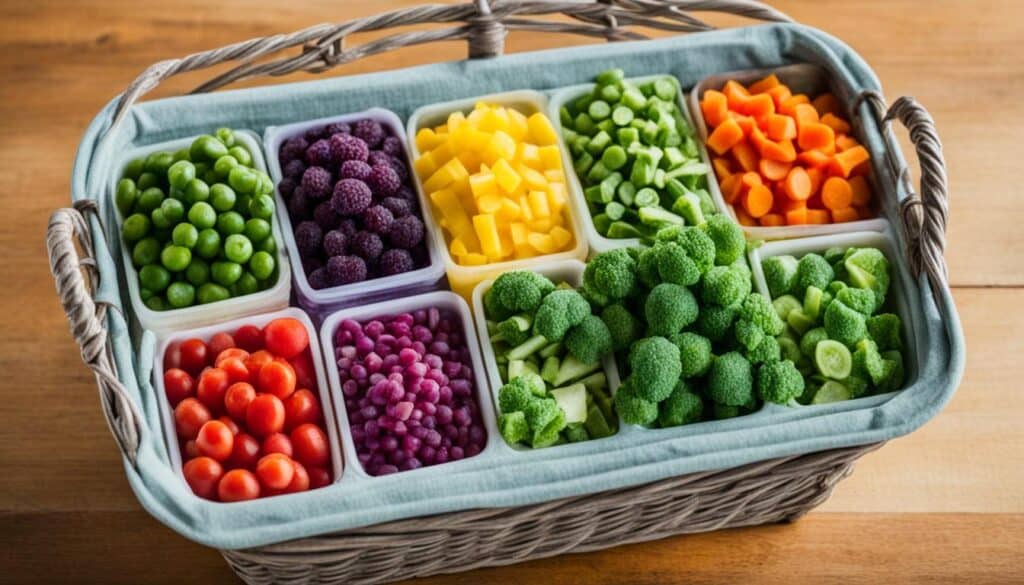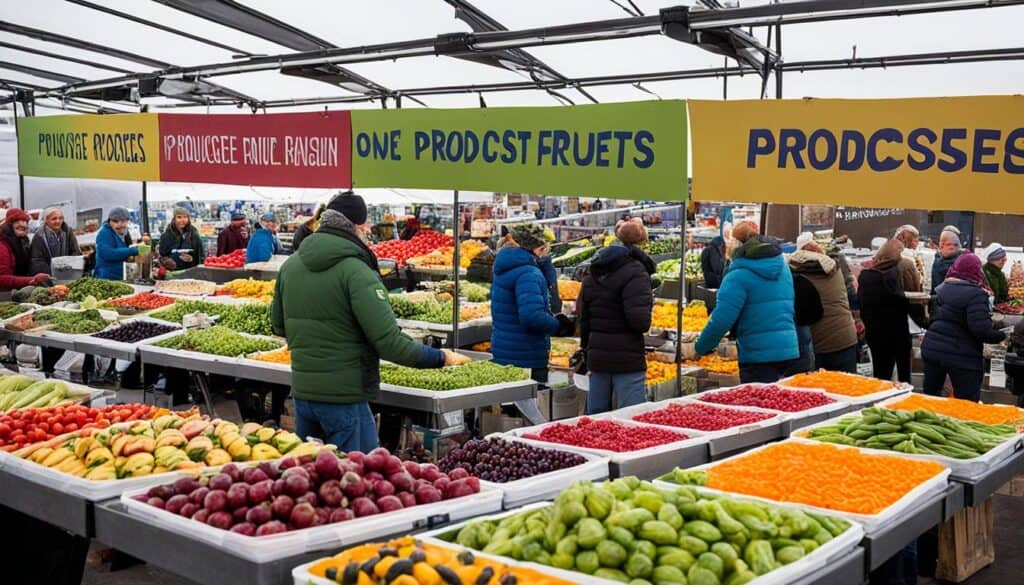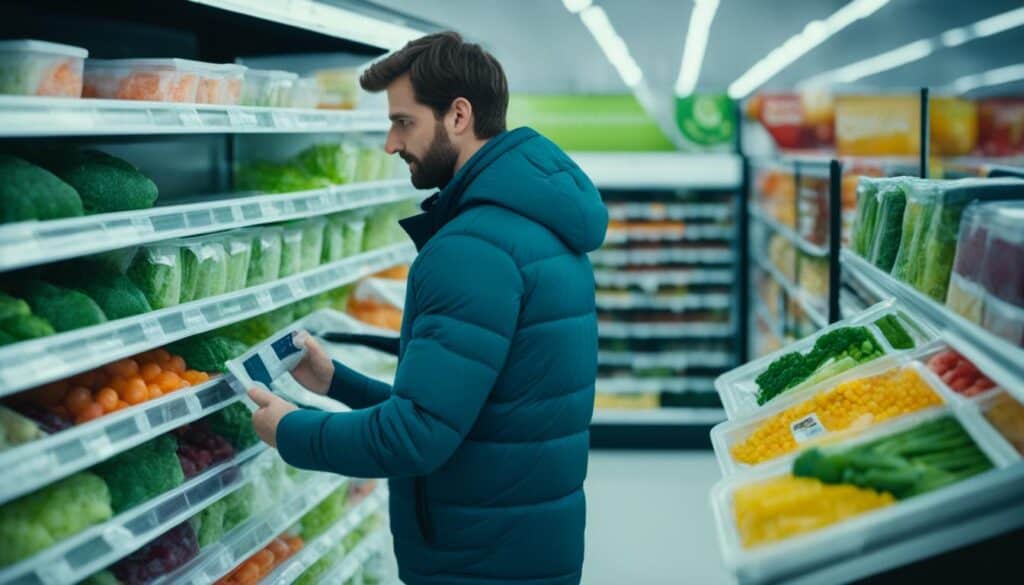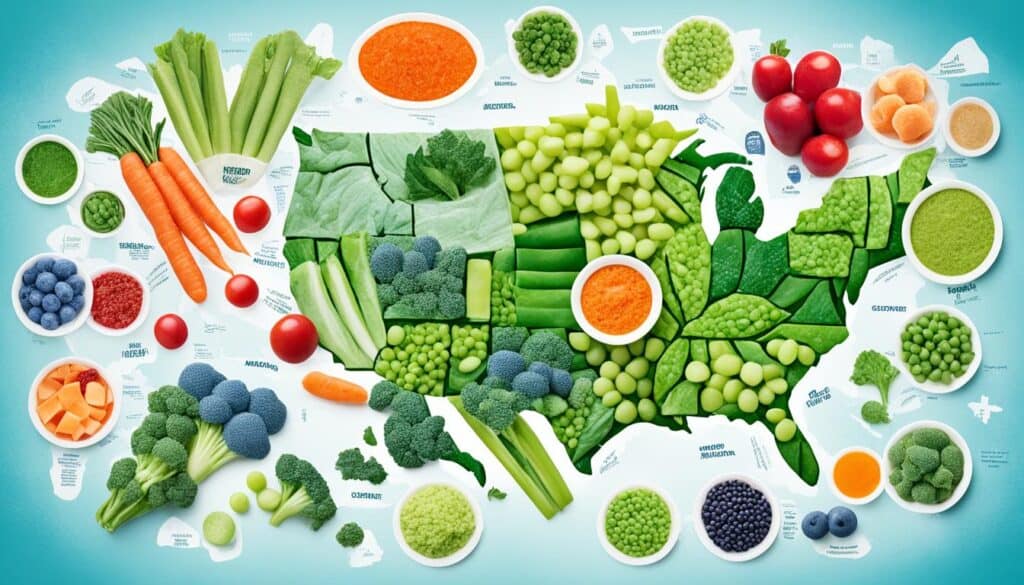Did you know that frozen vegetables can be just as nutritious as fresh ones, and sometimes even more so? That’s right! Contrary to common belief, research has shown that freezing is an effective method of preserving nutrients in fruits and vegetables, making frozen veggies a convenient and healthy choice for everyday meals. So, it’s time to give frozen vegetables a fresh look and uncover the amazing benefits they offer.
Key Takeaways:
- Frozen fruits and vegetables are just as nutritious as their fresh counterparts, and sometimes even more so.
- Freezing is an effective method of preserving nutrients in fruits and vegetables.
- Frozen veggies are often picked at their peak ripeness, making them more nutrient-dense compared to fresh produce picked for storage and transport.
- Select frozen vegetables without added sauce or salt for a healthier option.
- Proper handling and storage of frozen veggies ensure food safety and maintain their quality.
The Nutritional Benefits of Frozen Veggies
When it comes to the nutritional value of fruits and vegetables, frozen options are often overlooked. However, frozen fruits and vegetables can be just as nutritious, if not more so, than their fresh counterparts. The freezing process is an effective method of preserving the vitamins and beneficial plant compounds found in these foods. In fact, frozen veggies are often picked at their peak ripeness, which means they are more nutrient-dense compared to fresh produce that is selected for storage and transport.
Studies have shown that frozen fruits and vegetables can retain a high level of vitamins, minerals, and antioxidants even after the freezing process. This means that you can still enjoy the same health benefits when consuming frozen veggies as you would with fresh ones. The nutrient retention in frozen veggies is a result of the quick freezing process, which helps to lock in essential nutrients.
“Frozen fruits and vegetables can contain just as many vitamins as fresh produce, if not more.”
In addition to their nutrient content, frozen fruits and vegetables also offer convenience. They have a longer shelf life compared to fresh produce, allowing you to have a variety of options readily available in your freezer. This can be especially beneficial for busy individuals or those who want to incorporate more fruits and vegetables into their diet without worrying about spoilage.
To illustrate the nutrient retention in frozen veggies, here is a comparison between the vitamin C content of fresh and frozen broccoli:
| Foods | Vitamin C (mg per 100g) |
|---|---|
| Fresh Broccoli | 89.2 |
| Frozen Broccoli | 85.2 |
The table demonstrates that frozen broccoli retains a significant amount of vitamin C compared to its fresh counterpart. This indicates that frozen veggies can be a reliable source of essential nutrients.
The Safety of Frozen Veggies
Frozen fruits and vegetables provide a convenient and healthy option for everyday meals. When it comes to safety, you can rest assured that frozen veggies are generally safe for consumption and do not pose a risk of harmful bacteria. In fact, a study examining over 300 samples of produce found no harmful bacteria in frozen veggies.
However, it is still important for consumers to take necessary precautions and handle frozen veggies properly to ensure food safety. Here are some key precautions to keep in mind:
Proper Handling and Storage
When purchasing frozen veggies, check the packaging for any signs of damage or thawing. Avoid packages with ice crystals or stains, as this may indicate that the veggies have thawed and refrozen. It’s best to choose packages that feel solid and hard.
Once you bring your frozen veggies home, store them in the freezer immediately. Keep them at the back of the freezer, where the temperature remains consistently cold. Minimize the number of times you open the freezer door to maintain the quality of the veggies.
Thawing and Cooking
When it comes to cooking frozen veggies, there’s no need to thaw them beforehand. You can cook them directly from their frozen state. However, if you prefer to thaw them, do so in the refrigerator or under cold running water.
When cooking frozen veggies, follow the instructions on the packaging for the recommended cooking time and temperature. Ensure that the veggies are heated thoroughly to kill any potential bacteria.
Safe Consumption
Before consuming frozen veggies, ensure they are fully cooked. Check that they are piping hot throughout. Avoid eating partially cooked or raw frozen veggies, as this may increase the risk of foodborne illness.
By following these precautions, you can safely enjoy the convenience and nutritional benefits of frozen veggies. Remember, while frozen veggies are generally safe, it’s essential to handle and cook them properly to maintain food safety.
The Best Nutrient Retention Methods in Freezing
When it comes to preserving the nutrients in frozen vegetables, blanching is a commonly used method. By exposing the vegetables to hot water temperatures, blanching effectively destroys enzymes that can cause discoloration and loss of flavor, ensuring that your frozen veggies retain their vibrant colors and delicious taste.
However, it’s important to note that blanching can lead to a loss of up to 50% of heat-sensitive vitamin C in the vegetables. While this may seem like a significant loss, it’s essential to consider the overall nutrient content in frozen veggies compared to their commercially fresh counterparts.
Despite the potential loss of some vitamin C during the blanching process, frozen vegetables, including blanched ones, still retain a higher nutrient content overall. This is because frozen veggies are often picked at their peak ripeness, when their nutrient levels are at their highest. In contrast, commercially fresh produce may undergo non-frozen transport and storage, which can lead to nutrient degradation over time.
So, while blanching may result in a slight reduction in vitamin C, the retention of other nutrients, such as vitamins A, K, and B, along with minerals like iron and potassium, make frozen veggies a valuable and nutritious choice for your meals.
By choosing frozen vegetables, you can enjoy the convenience of having nutritious options readily available in your freezer while still providing your body with the essential vitamins and minerals it needs.
“Blanching is a commonly used method that helps preserve the vibrant colors and flavors of frozen vegetables while ensuring they retain a higher nutrient content overall.”
Now that we understand the importance of blanching in preserving the nutrients in frozen veggies, let’s explore some tips for choosing the best quality frozen vegetables.
Choosing the Best Frozen Veggies
When it comes to selecting frozen vegetables, there are a few important factors to consider to ensure you get the best quality and nutritional value. Here are some tips and signs of quality to keep in mind:
- Choose veggies without added sauce or salt: Opting for frozen vegetables without added sauces or salt is a healthier choice. This allows you to control the seasoning and sodium content according to your preferences and dietary needs.
- Check the packaging: The packaging should feel solid and hard, indicating that the contents have not thawed and refrozen. Thawing and refreezing can affect the texture and quality of the vegetables.
- Inspect for staining or ice crystals: Stains or the presence of ice crystals on the package can be signs that the vegetables have undergone thawing and refreezing. This can compromise the taste and texture, so it’s best to choose packages that are free from these signs.
Proper storage is also crucial to maintain the quality of frozen veggies. Store them at the back of the freezer: This helps protect them from temperature fluctuations caused by frequent opening and closing of the freezer door. Minimize freezer door opening: Every time the freezer door is opened, warm air enters, which can lead to the formation of ice crystals on the veggies.
To summarize, when selecting frozen veggies, look for options without added sauce or salt, check the packaging for solidity and absence of staining or ice crystals, and store them properly to maintain their quality.
By following these tips and being mindful of the signs of quality, you can make informed choices and enjoy the full benefits of frozen vegetables in your meals.
The Rise of Processed Fruits and Vegetables Market
The processed fruits and vegetables market is projected to reach a value of USD 106.5 billion by 2030. This growing market is driven by the increasing popularity of processed food and the rise in urbanization. Among the various segments, canned products currently hold the largest share, while frozen products are experiencing the fastest growth. The convenience and longer shelf life of processed fruits and vegetables make them an attractive choice for consumers.
In recent years, the processed fruits and vegetables market has witnessed significant growth due to changing consumer lifestyles and the demand for convenient and ready-to-eat food options. Processed fruits and vegetables offer several advantages, including extended shelf life, year-round availability, and ease of use in cooking and meal preparation.
Furthermore, the global market size for processed fruits and vegetables is expected to experience substantial growth in the coming years. The increasing demand for healthy and nutritious food products, coupled with the expanding foodservice industry, is driving the market’s expansion.
Forecast for 2030
Based on market research and industry projections, the processed fruits and vegetables market is expected to continue its upward trajectory. By 2030, the market is forecasted to reach a value of USD 106.5 billion, demonstrating substantial growth and opportunities for businesses in this sector.
The market’s expansion is expected to be driven by several factors, including:
- The rising preference for convenient food options
- The increasing demand for processed and ready-to-eat meals
- The growing urban population, leading to a higher demand for processed fruits and vegetables
- Technological advancements in food processing and preservation
The processed fruits and vegetables market offers immense potential for companies operating in this industry. With changing consumer preferences and the need for convenient, nutritious food, the market presents opportunities for both established players and new entrants.
To capitalize on the forecasted growth and meet consumer demand, companies must focus on innovation, product development, and maintaining high-quality standards. Continuous research and development will be key to stay ahead of the competition and provide consumers with a wide range of processed fruits and vegetables that meet their preferences and dietary requirements.
| Segment | Market Size |
|---|---|
| Canned Products | $XX billion |
| Frozen Products | $XX billion |
| Other Processed Products | $XX billion |
The Distribution Channels of Processed Veggies
When it comes to buying processed veggies, consumers have the convenience of choosing from both offline and online distribution channels. Offline channels, such as grocery stores and supermarkets, have been a traditional and trusted source for purchasing processed vegetables. These physical stores allow customers to personally examine the products, check for freshness, and make well-informed decisions about their purchases. With the ability to touch, feel, and see the products firsthand, offline distribution channels provide a level of assurance and confidence to buyers.
On the other hand, online distribution channels have gained tremendous popularity in recent years. The rapid growth of e-commerce has revolutionized the way people shop for processed veggies. Online platforms, such as e-grocery stores and food delivery apps, offer the convenience of ordering processed veggies from the comfort of home, with just a few clicks. This accessibility makes online shopping an attractive option for busy individuals or those who prefer the ease of doorstep delivery.
The rise of internet usage has greatly contributed to the growth of online distribution channels for processed veggies. With people spending more time online, shopping for groceries from their smartphone or computer has become a norm. The online sector provides a wide variety of options and allows consumers to compare prices, read reviews, and make informed decisions at their own pace.
“Online channels offer the convenience of shopping for processed veggies from the comfort of home.”
To highlight the distribution channels of processed veggies, let’s compare the advantages of buying offline and online:
| Offline Distribution Channels | Online Distribution Channels |
|---|---|
| Physical examination of products | Convenience of shopping from home |
| Assurance of freshness | Wide variety of options |
| Immediate availability | Ability to compare prices and read reviews |
| Personalized customer service | Flexible delivery options |
Both offline and online distribution channels have their own unique benefits, allowing consumers to choose the option that best suits their preferences and lifestyle. Whether it’s the convenience of online shopping or the trust and assurance of physical stores, the availability of processed veggies in different distribution channels ensures that customers can easily access these nutritious and convenient food options.
Regional Insights in Processed Veggies Market
When it comes to the global processed vegetables market, North America, especially the United States and Canada, takes the lead. This region’s market dominance is driven by a growing focus on health and an increasing preference for processed veggies. Consumers in North America are becoming more conscious of their dietary choices and are opting for convenient and nutritious options like processed vegetables.
On the other side of the globe, the Asia Pacific region is witnessing the fastest growth rate in the processed veggies market. Countries like China, India, and Japan contribute significantly to this growth, thanks to their sizable population and increasing demand for processed and frozen goodies. As urbanization continues to rise in the Asia Pacific region, so does the consumption of processed veggies.
The Rise of Processed Fruits and Vegetables Market
“North America, particularly the United States and Canada, leads the global processed vegetables market.”
“In Asia Pacific, countries like China, India, and Japan contribute to the fastest growth rate in the market.”
Table: Regional Market Insights
| Region | Key Drivers |
|---|---|
| North America | – Growing focus on health – Increasing preference for processed veggies |
| Asia Pacific | – Sizable population – Rising urbanization – Demand for processed and frozen goodies |
The processed veggies market in North America is driven by health consciousness and the convenience of processed veggies, while Asia Pacific experiences rapid growth due to a combination of population size and urbanization. These factors contribute to the regional dynamics and market opportunities in both North America and the Asia Pacific.
Market Dynamics of Processed Veggies
As the demand for processed vegetables continues to grow, various factors contribute to the expansion and evolution of the market. Let’s explore the drivers and restraints shaping the processed veggies industry.
The Drivers of Processed Veggies Market
One significant driver of the processed veggies market is the foodservice industry’s demand for cost-effective and convenient ingredients for large-scale cooking. Processed and frozen veggies provide an efficient solution, as they eliminate the need for extensive preparation and minimize waste. This demand from restaurants, cafes, and catering services contributes to the market’s growth and sustains the production of processed veggies.
“The foodservice industry’s preference for processed and frozen veggies stems from their cost-effectiveness and convenience in large-scale cooking.”
Furthermore, the increasing popularity and demand for processed veggies in households also drive market growth. As consumers become more conscious of health and convenience, they are turning to processed veggies as a convenient alternative to fresh produce. The extended shelf life, easy storage, and preserved nutrients offered by frozen and canned veggies make them an attractive choice for busy individuals and families seeking nutritious meal options.
The Restraints of Processed Veggies Market
While the processed veggies market experiences continuous growth, it faces certain challenges that act as restraints. Seasonal availability and weather conditions significantly impact the supply chains and costs associated with processing and distributing vegetables. Variations in crop yields due to weather patterns can cause fluctuations in production and availability, affecting market stability and pricing.
Additionally, logistical challenges, such as transportation costs and storage facilities, can create restraints within the market. Maintaining the cold chain for frozen veggies and ensuring proper storage conditions for canned products can increase costs and pose logistical complexities for manufacturers and distributors.
“Seasonal availability and weather conditions affect the supply chains and costs of processed veggies, posing challenges to the market.”
| Drivers | Restraints |
|---|---|
| • Demand from foodservice industry • Increasing popularity and demand in households |
• Seasonal availability • Weather conditions • Logistical challenges |
Conclusion
The processed fruits and vegetables market is booming, and it’s no surprise that frozen veggies are leading the way. As a consumer, I’m thrilled to have access to nutritious and convenient options like frozen veggies. They offer a longer shelf life, which means less waste, and their nutrients are preserved through the freezing process. It’s a win-win situation for both taste and health!
With the market growing rapidly, more and more people are recognizing the benefits of processed veggies. Whether it’s the convenience of canned veggies or the freshness of frozen ones, these products have become a significant part of the global food industry. And why not? They provide a practical solution for busy individuals and families who want to maintain a healthy diet without compromising on taste or nutrition.
So, the next time you’re at the grocery store, consider exploring the processed veggies aisle. You’ll find an array of options that can elevate your meals and simplify your cooking routine. From frozen vegetable mixes to canned varieties, there’s something for everyone. Embrace the convenience, embrace the nutrition, and embrace the deliciousness of processed veggies. Your taste buds and your body will thank you!










Leave a Reply